Book of Mormon Printer's Manuscript, Photos of Seer Stone Featured in New Book
Contributed By R. Scott Lloyd, Church News staff writer

Bloggers Joe Spencer and Ben Spackman look at the new Joseph Smith Papers volume during a news conference announcing the release of the printer's manuscript of the the Book of Mormon on August 4, 2015.
Article Highlights
- Featured in a new volume of the Joseph Smith Papers are photographs of the printer's manuscript of the Book of Mormon and a brown seer stone likely used by the Prophet Joseph Smith in his translation of the Book of Mormon.
“We’re pleased that this document will now be available for scholars and members of the Church to review and study as they desire.” —Elder Steven E. Snow of the Seventy
Related Links
The most extensive early text of the Book of Mormon—the printer’s manuscript from which the earliest edition was set in type—is now accessible to the public through the latest volume in the Joseph Smith Papers project.
Revelations and Translations, Volume 3: Printer’s Manuscript of the Book of Mormon was announced August 4 at a news conference at the Church History Library in Salt Lake City. Representatives of the Church History Department and of the Community of Christ were on hand for the launch of this, the 11th published volume of the project.
Elder Steven E. Snow of the Seventy, Church Historian and Recorder, explained that the original manuscript of the Book of Mormon—the one scribes wrote as the Prophet Joseph Smith dictated it—was mostly destroyed from water damage after it was placed inside the cornerstone of the Nauvoo House in Nauvoo, Illinois, in 1841.
When it was removed 41 years later, much of it was unrecoverable, and only about 30 percent exists today. That remnant is in the custody of the Church History Department.
“So the printer’s manuscript, which is included in this volume, is the most complete early text of the Book of Mormon,” Elder Snow said, adding that the manuscript was copied primarily by the Prophet’s scribe, Oliver Cowdery, for use by E. B. Grandin, the printer in Palmyra, New York, who was contracted to produce the first Book of Mormon edition.
“It was hand copied and delivered to the printer several pages at a time, as it was ready,” Elder Snow said. “The manuscript contains 464 pages, a title page, and a preface by Joseph Smith.”
After publication in 1837 of the second Book of Mormon edition, Oliver Cowdery retained possession of the printer’s manuscript, according to an explanatory video on the Joseph Smith Papers website. “Before dying, he presented this manuscript to David Whitmer,” said volume editor Robin Scott Jensen on the video. “It’s largely due to the Whitmer family that we have the manuscript today,” as it was preserved by David and his descendants.
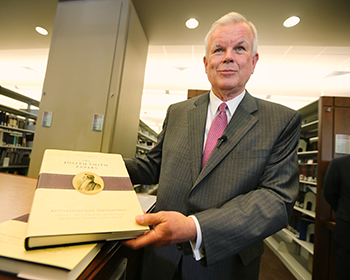
Elder Steven E. Snow of the Seventy and Church Historian and Recorder shows the new volume of the Joseph Smith Papers during a press conference Tuesday, August 4, 2015, at the Church History Library in Salt Lake City. Photo by Scott G Winterton, Deseret News.
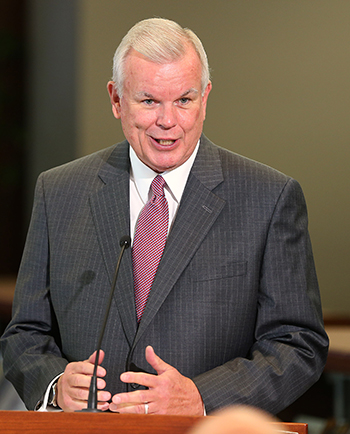
Elder Steven E. Snow of the Seventy and Church Historian and Recorder talks about the new volume of the Joseph Smith Papers during a press conference Tuesday, August 4, 2015, at the Church History Library in Salt Lake City. Photo by Scott G Winterton, Deseret News.
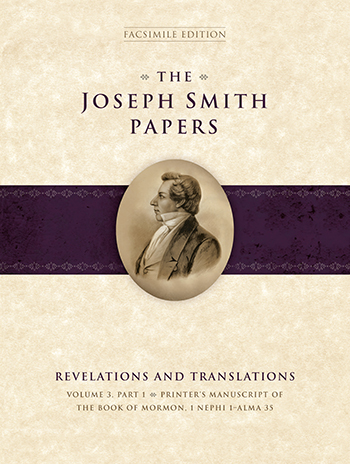
The third volume of the Joseph Smith Papers includes the printer's manuscript of the Book of Mormon.
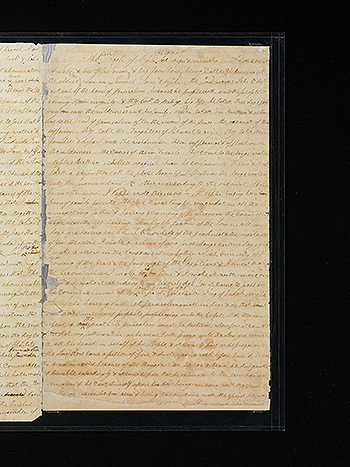
This is the first page of the printer’s manuscript of the Book of Mormon.
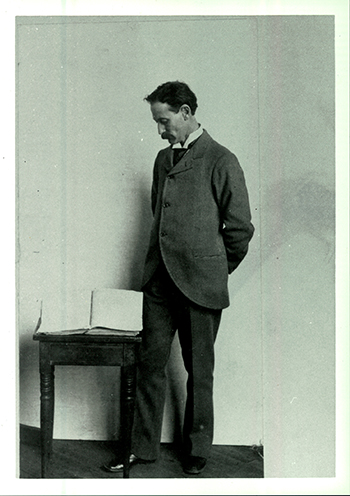
George Schweich, a grandson of David Whitmer, stands next to the printer’s manuscript of the Book of Mormon. George Schweich inherited the manuscript from his grandfather and sold the manuscript in 1903 to the Reorganized Church of Jesus Christ of Latter Day Saints, later renamed the Community of Christ, where it has remained until the present. © Image courtesy Community of Christ Library-Archives. All rights reserved.
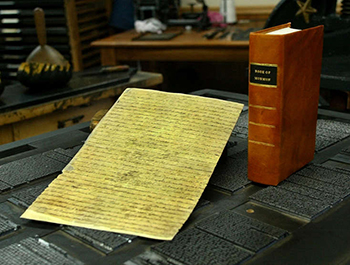
A photograph copy of the original printer’s manuscript for the first printing of the Book of Mormon sits next to a leather-bound copy of the first printed edition of the Book of Mormon. Photo by Stuart Johnson, Deseret News.
“In 1903, this manuscript was acquired by the Community of Christ, then known as the Reorganized Church of Jesus Christ of Latter Day Saints,” Elder Snow said at the news conference, adding that he was privileged in 2011 to see and hold the manuscript, which is in the Community of Christ archives in Independence, Missouri.
“It’s really a wonderful document, and we’re pleased that this document will now be available for scholars and members of the Church to review and study as they desire,” he said, adding that it will eventually be accessible online free of charge, as will all volumes of the Joseph Smith Papers.
This latest release comprises two oversize hardbound books, identified as parts 1 and 2. Each measuring 9 inches by 12 inches, the books contain full-color photographic reproductions of all of the pages in the printer’s manuscript, each with a facing page containing a printed transcription of the text on the respective manuscript page.
“We were committed to a comprehensible treatment, and so as a result the text is over 1,000 pages,” Elder Snow noted.
“Annotation in this volume indicates significant variants between the printer’s manuscript and the extant portion of the original manuscript, as well as the 1830, 1837, and 1840 editions of the Book of Mormon,” he explained.
Featured in the new volume are photographs of a brown seer stone likely used by the Prophet Joseph Smith in his translation of the Book of Mormon.
“This is the first time the Church has published images of this seer stone,” Elder Snow noted. “They’re beautiful, and we hope that both the images and the discussion of this sacred object will add to the understanding about the translation of the Book of Mormon.”
An article written for the October edition of the Ensign magazine titled “Joseph the Seer” was placed on the Church’s website coinciding with the news conference. It also includes a photo of the seer stone. The article explains the role of the seer stone in the Book of Mormon translation and its relationship to the Nephite interpreters that Joseph Smith found with the gold plates on which the Book of Mormon was inscribed and which he also used in the process of translation. The article was written by Richard E. Turley Jr., assistant Church historian and recorder, and his colleagues Robin Scott Jensen and Mark Ashurst-McGee.
Elder Snow praised the cooperation of the Community of Christ in making the published work possible.
“This is one of the best and most recent examples of the cooperation between the two churches in helping us preserve and present our common Restoration past,” he said. “They have been careful stewards of the manuscripts in their collection, which are extensive, and we’ve had the privilege of working with them in helping with conservation of some documents. We’ve really appreciated their willingness to share these sacred and important documents.”
He said the groundwork for this latest publication was laid decades ago by earlier generations.
President Robin Linkhart, a member of the Presidency of the Seventy in the Community of Christ, expanded on what Elder Snow said, recounting that RLDS historian emeritus Richard P. Howard and former LDS Church archivist Earl E. Olsen “pioneered the way to scholarly exchange of historical documents.”
President Linkhart recounted that in 1968, the RLDS Church granted onsite access to Brigham Young University scholar Robert B. Matthews to examine the manuscript for Joseph Smith’s new translation of the Bible. That work led to the inclusion of Joseph Smith Translation excerpts among study aids in all LDS editions of the King James Bible since 1978.
“LDS Church historian Leonard Arrington and [Richard P.] Howard … painstakingly built solid bridges of collegiality between the two church history departments,” President Linkhart said. “Their efforts eventually led to the practice of document exchanges for historical research beginning in 1974.
“In response to Royal Skousen’s initial contact in 1988, Church historian Richard Howard worked with Community of Christ ecclesiastical leaders to make the printer’s manuscript available to him.”
Brother Skousen is one of two volume editors of this latest Joseph Smith Papers release. It is built upon his earlier work examining the text of the Book of Mormon and his multivolume publication of a typescript copy of the printed manuscript.
In an interview following the announcement, Brother Turley explained more about the printer’s manuscript, essentially a backup copy of the original document, which historians sometimes refer to as the “dictation manuscript.”
“After Joseph’s experience with Martin Harris and the loss of 116 pages of manuscript, he learned a lesson that all of us with computers learn, which is backup, backup, backup,” Brother Turley remarked.
He assigned Oliver Cowdery, his own brother Hyrum Smith, and a third scribe, whom historians have not been able to identify, to the work of copying the manuscript, Brother Turley explained.
“That backup copy was then the principal copy used for printing the Book of Mormon. Joseph Smith did not want to turn the dictation manuscript over to the printer and risk the possibility of having it disappear. So it was mostly the printer’s manuscript that was taken to the print shop in segments and used for the publication.
“I say ‘mostly,’ because at one point, we find in the original manuscript some printer’s marks which suggest that at one point—either the scribes fell behind in making the copy or for some other reason—they sent in a portion of the original. But, for the most part, it was the printer’s manuscript that was used for the typesetting.“
Brother Turley said the new Joseph Smith Papers volume tracks with colored ink the changes that were made in the text over time by scribes.
“Most of the changes were made for the 1837 second edition, in which they corrected for speakers of what you might call standard American English,” he remarked, “some of what was originally Joseph Smith’s dialect in which he dictated the Book of Mormon.”
Lachlan Mackay, director of historic sites for the Community of Christ, said he sees in the new Joseph Smith Papers release the culmination of decades of cooperation and healing in the relationship between the LDS and Community of Christ churches.
He noted that custody of Joseph Smith’s papers was one of the issues of conflict between Joseph’s widow, Emma, and President Brigham Young.
“One of the things that divided friends and family is now a cause for uniting us in the pursuit of open and honest scholarship,” he said. “For me, that’s one of the most exciting things about this project and the Joseph Smith Papers in general.”
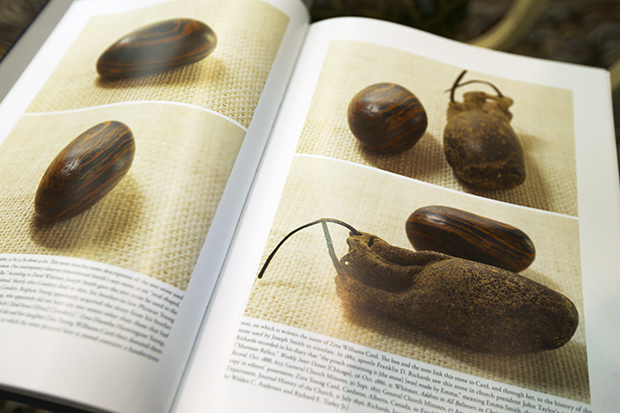
Photos of the seer stone in the new volume of the Joseph Smith Papers. Photo by Scott G Winterton, Deseret News.
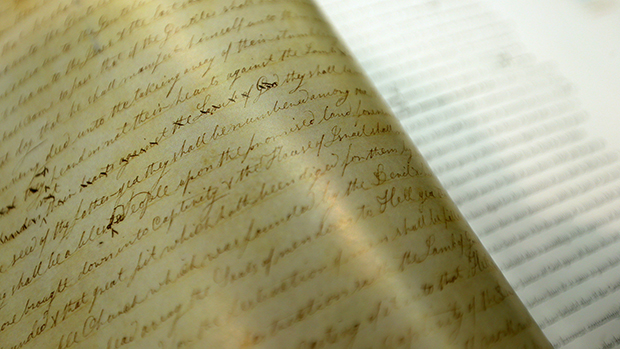
The Church, in cooperation with the Community of Christ, announced the release of the printer’s manuscript of the Book of Mormon during a press conference August 4, 2015. Photo by Scott G Winterton, Deseret News.
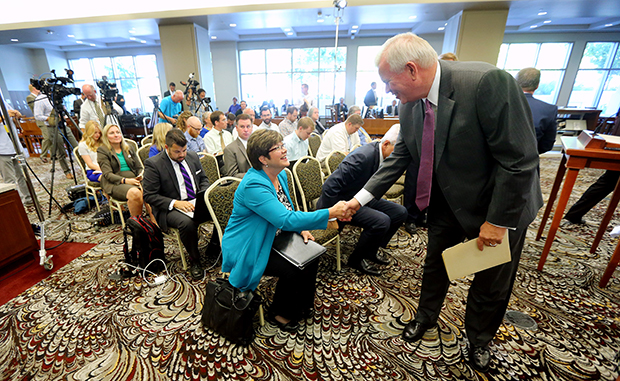
LDS Church Historian and Recorder Elder Steven E. Snow shakes hands with President Robin Linkhart of the Community of Christ's Presidency of the Seventy. The two churches announced the release of the printer’s manuscript of the Book of Mormon during a press conference August 4. Photo by Scott G Winterton, Deseret News.
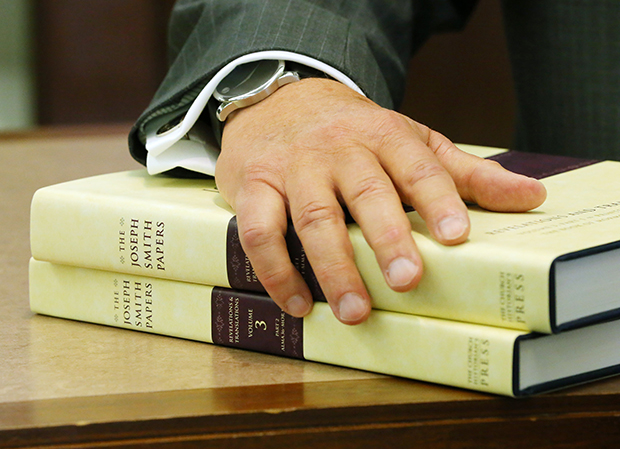
Elder Steven E. Snow, Church Historian and Recorder, rests his hand on a pair of the new volumes of the Joseph Smith Papers during a news conference August 4 announcing the release of the printer’s manuscript of the Book of Mormon. Photo by Scott G Winterton, Deseret News.
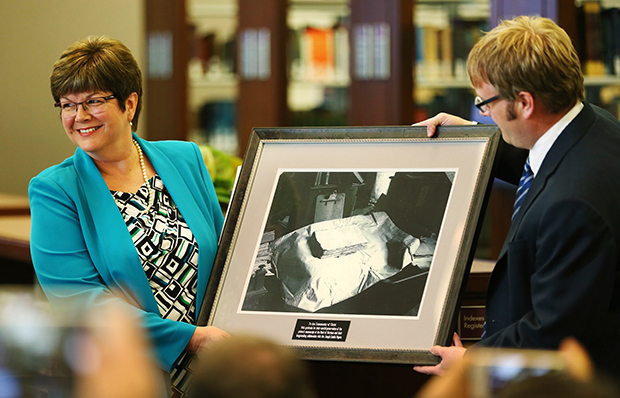
President Robin Linkhart of the Community of Christ is given a photo of the original printer’s manuscript during a press conference August 4, 2015, announcing the release of the printer’s manuscript of the Book of Mormon. Photo by Scott G Winterton, Deseret News.
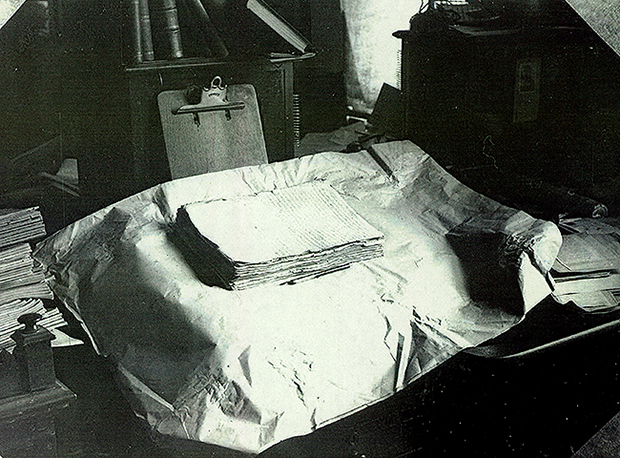
The printer’s manuscript of the Book of Mormon rests on a table in this early 20th-century photograph. © Image courtesy Community of Christ Library-Archives. All rights reserved.
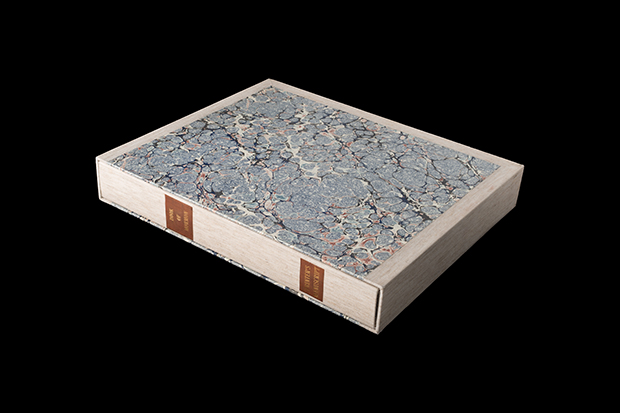
This case encloses the printer’s manuscript of the Book of Mormon, protecting and preserving the manuscript for future researchers and interested Church members. © Image courtesy Church History Library. All rights reserved.
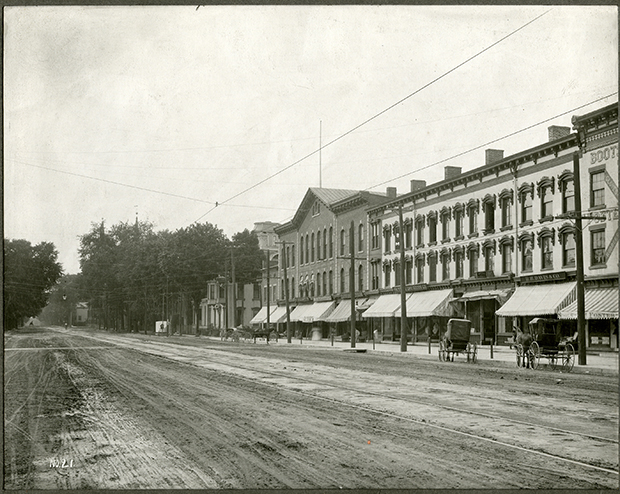
This historic photograph shows the Grandin building in Palmyra, New York, where the 1830 edition of the Book of Mormon was published.
